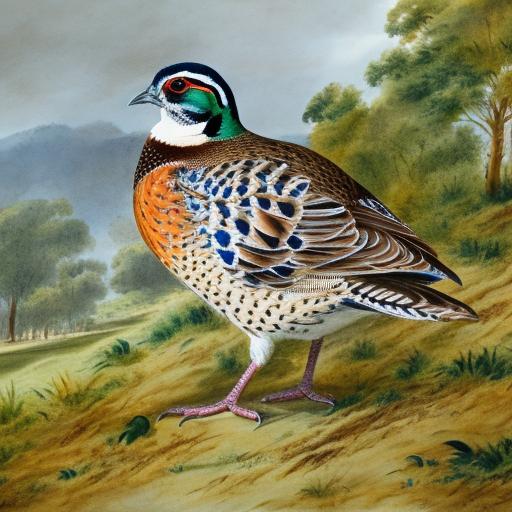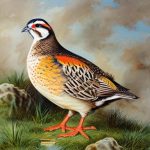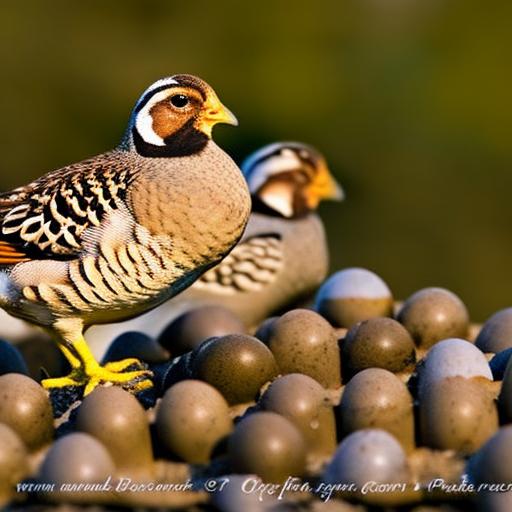Quails are small, ground-dwelling birds that belong to the pheasant family. They are known for their delicious eggs and meat, making them popular among poultry enthusiasts. There are many different breeds of quail, each with its own unique characteristics and traits. Some quail breeds are larger than others, and these larger breeds are often sought after for their meat production and egg-laying capabilities. In this article, we will explore the characteristics, care, and uses of the largest quail breeds, as well as provide tips for housing, breeding, and rearing these birds.
Key Takeaways
- Quail breeds come in various sizes, with some being larger than others.
- The largest quail breeds are known for their impressive size and unique characteristics.
- The top 3 largest quail breeds are Jumbo Coturnix, Italian, and Tibetan quail.
- Housing and care for large quail breeds require spacious enclosures and proper nutrition.
- Breeding and rearing large quail breeds can be a rewarding experience for poultry enthusiasts.
Characteristics of the Largest Quail Breeds
The largest quail breeds are known for their size and meat production capabilities. These breeds typically have a plump body, making them ideal for meat production. They also tend to lay larger eggs compared to smaller quail breeds. In terms of color, the largest quail breeds come in a variety of shades, including brown, white, and speckled patterns. Their plumage is often attractive and can vary greatly depending on the specific breed. Additionally, these larger quail breeds are known for their hardiness and adaptability to different climates, making them suitable for a wide range of environments. They are also relatively easy to care for and can thrive in both backyard settings and commercial operations.
The largest quail breeds are also known for their calm and docile temperament, which makes them easier to handle and manage compared to more skittish breeds. This makes them a popular choice for beginners and experienced poultry keepers alike. Additionally, these larger quail breeds have a relatively fast growth rate, reaching maturity in as little as 6-8 weeks. This makes them an attractive option for those looking to raise quail for meat production. Overall, the largest quail breeds are prized for their size, meat production capabilities, egg-laying abilities, and ease of care.
Top 3 Largest Quail Breeds
1. Jumbo Coturnix Quail: The Jumbo Coturnix quail is one of the largest quail breeds available. They are known for their rapid growth rate and large size, making them a popular choice for meat production. These quails come in a variety of colors, including brown, white, and speckled patterns. They are also prolific layers, producing large eggs that are highly sought after for their rich flavor. Jumbo Coturnix quails are known for their calm and docile temperament, making them easy to handle and manage. They are also relatively low-maintenance birds, making them an ideal choice for both backyard enthusiasts and commercial operations.
2. Italian Speckled Quail: The Italian Speckled quail is another large breed that is prized for its meat production capabilities. These quails have a plump body and come in a striking speckled pattern, making them an attractive addition to any flock. They are known for their hardiness and adaptability to different climates, making them suitable for a wide range of environments. Italian Speckled quails are also prolific layers, producing large eggs that are highly prized for their rich flavor. They have a calm and docile temperament, making them easy to handle and manage. Overall, the Italian Speckled quail is a popular choice for those looking to raise quail for meat production and egg-laying.
3. Tibetan Quail: The Tibetan quail is one of the largest quail breeds available, known for its impressive size and meat production capabilities. These quails have a plump body and come in a variety of colors, including brown and white. They are known for their hardiness and adaptability to different climates, making them suitable for a wide range of environments. Tibetan quails are also prolific layers, producing large eggs that are highly prized for their rich flavor. They have a calm and docile temperament, making them easy to handle and manage. Overall, the Tibetan quail is a popular choice for those looking to raise quail for meat production and egg-laying.
Housing and Care for Large Quail Breeds
When it comes to housing and caring for large quail breeds, there are several important factors to consider. Firstly, it’s essential to provide adequate space for these birds to move around freely. A good rule of thumb is to allow at least 1 square foot of space per bird in the coop or housing area. This will help prevent overcrowding and reduce the risk of aggression or stress among the birds. Additionally, it’s important to provide a secure and predator-proof housing structure to protect the quails from potential threats such as predators or extreme weather conditions.
In terms of bedding, it’s important to use a suitable material that provides good insulation and absorbs moisture effectively. Common bedding options include straw, wood shavings, or sand. Regular cleaning and maintenance of the bedding are essential to ensure a clean and healthy living environment for the quails. Furthermore, providing access to fresh water and a balanced diet is crucial for the health and well-being of large quail breeds. A high-quality commercial feed formulated specifically for quails can provide the essential nutrients they need for growth, egg production, and overall health. Additionally, offering access to grit or small stones can help aid in digestion and nutrient absorption.
Varying the language:
Large quail breeds also require access to a suitable outdoor area where they can forage, dust bathe, and exercise. Providing access to a secure outdoor run or free-range area can help fulfill their natural behaviors and improve their overall well-being. It’s important to ensure that the outdoor area is protected from potential predators and provides adequate shelter from the elements. Regular monitoring of the birds’ health and behavior is essential to identify any potential issues early on. This includes observing their eating habits, activity levels, and overall appearance.
Breeding and Rearing Large Quail Breeds
Breeding and rearing large quail breeds can be a rewarding experience for poultry enthusiasts. When it comes to breeding these birds, it’s important to select healthy breeding stock with desirable traits such as size, temperament, and egg-laying capabilities. Providing a suitable breeding environment with ample nesting boxes, privacy, and comfortable bedding can help encourage successful breeding behavior. It’s important to monitor the breeding pairs closely and provide any necessary assistance or intervention if needed.
Once the eggs are laid, they should be collected promptly and placed in a suitable incubator set at the appropriate temperature and humidity levels. Regular monitoring of the incubation process is essential to ensure optimal hatch rates. Once the chicks hatch, they should be provided with a warm and safe brooding area equipped with heat lamps or brooder plates to maintain the ideal temperature. A high-quality starter feed formulated specifically for young quails can provide the essential nutrients they need for healthy growth and development.
As the chicks grow, they should be gradually transitioned to a suitable grower feed that supports their nutritional needs as they mature. Providing access to clean water at all times is crucial for their health and well-being. Regular monitoring of the chicks’ growth, behavior, and overall health is essential to identify any potential issues early on and provide any necessary care or intervention.
Uses of Large Quail Breeds

Large quail breeds have several uses that make them valuable additions to any poultry operation or backyard flock. One of the primary uses of these birds is meat production. Their plump bodies and rapid growth rate make them an excellent source of lean protein-rich meat that is prized for its delicious flavor. The meat from large quail breeds is often used in various culinary dishes and is highly sought after by chefs and home cooks alike.
In addition to meat production, large quail breeds are also valued for their egg-laying capabilities. These birds are prolific layers, producing large eggs that are rich in flavor and highly prized by consumers. Quail eggs are often used in gourmet cooking, baking, and as a delicacy in many cultures around the world. Their small size and unique flavor make them a popular choice among food enthusiasts looking to add a special touch to their dishes.
Furthermore, large quail breeds can also be raised for exhibition or show purposes. Their attractive plumage, calm temperament, and impressive size make them popular choices for poultry exhibitions and competitions. Many enthusiasts enjoy showcasing their large quail breeds at local fairs, agricultural shows, or poultry events.
Overall, large quail breeds have several valuable uses including meat production, egg-laying capabilities, and exhibition purposes that make them versatile additions to any poultry operation or backyard flock.
Conclusion and Considerations for Keeping Large Quail Breeds
In conclusion, large quail breeds offer several unique characteristics that make them valuable additions to any poultry operation or backyard flock. Their impressive size, meat production capabilities, egg-laying abilities, calm temperament, and adaptability make them popular choices among poultry enthusiasts. When it comes to keeping large quail breeds, it’s important to provide adequate housing, care, breeding management, and consider their various uses.
It’s essential to ensure that these birds have access to suitable housing with ample space, secure structures, clean bedding, fresh water, balanced nutrition, outdoor areas for exercise, as well as regular monitoring of their health and behavior.
Breeding and rearing large quail breeds require careful selection of breeding stock, suitable breeding environments, proper incubation procedures, brooding management, nutrition support as they grow.
Lastly, considering their uses such as meat production, egg-laying capabilities, exhibition purposes can help poultry enthusiasts make informed decisions about keeping large quail breeds.
Overall, large quail breeds offer several benefits that make them valuable additions to any poultry operation or backyard flock when provided with proper care and management.
Large quail breeds, such as the Jumbo Coturnix and Italian, are known for their fast growth and high meat production, making them a great choice for those looking to raise quail for meat. Additionally, their larger size makes them easier to handle and process compared to smaller quail breeds. These breeds also tend to be more cold-hardy and have a higher egg production, making them a practical choice for those looking to raise quail for both meat and eggs. With proper care and management, large quail breeds can be a valuable and productive addition to any poultry operation or backyard flock.
If you’re interested in learning about different types of poultry, you might also want to check out this article on how to care for goslings. It provides valuable insights into raising and caring for geese, which can be a fascinating addition to any poultry enthusiast’s flock.
FAQs
What are the largest quail breeds?
The largest quail breeds include the Jumbo Coturnix quail, the Italian quail, and the Tibetan quail.
How big do the largest quail breeds get?
The largest quail breeds can grow to be around 10-12 inches in length and weigh between 8-12 ounces.
What are the characteristics of the largest quail breeds?
The largest quail breeds are known for their robust build, large size, and plump bodies. They also have a wide range of color variations and patterns.
What are the common uses for the largest quail breeds?
The largest quail breeds are commonly raised for their meat and eggs. They are also popular for hunting and as pets due to their size and gentle nature.
How do you care for the largest quail breeds?
Caring for the largest quail breeds involves providing them with a spacious and secure enclosure, a balanced diet, and proper veterinary care. They also require clean bedding, fresh water, and protection from predators.
Meet Walter, the feathered-friend fanatic of Florida! Nestled in the sunshine state, Walter struts through life with his feathered companions, clucking his way to happiness. With a coop that’s fancier than a five-star hotel, he’s the Don Juan of the chicken world. When he’s not teaching his hens to do the cha-cha, you’ll find him in a heated debate with his prized rooster, Sir Clucks-a-Lot. Walter’s poultry passion is no yolk; he’s the sunny-side-up guy you never knew you needed in your flock of friends!







